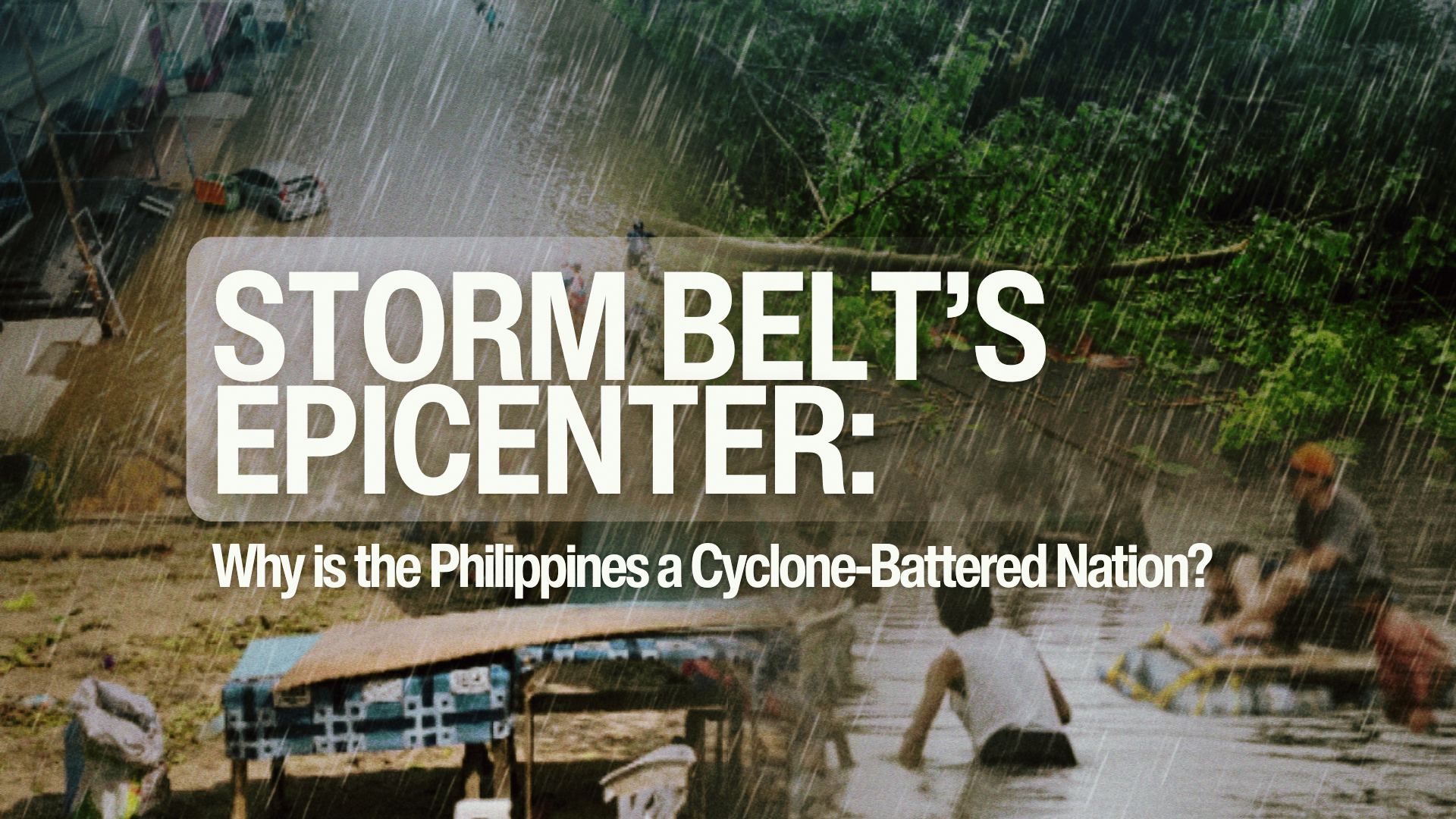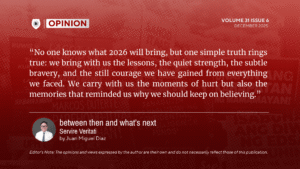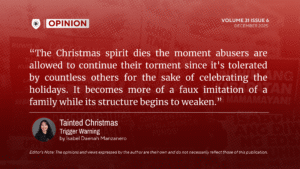Written by Kyla Shayn R. Ochabillo | August 14, 2025
Storm Belt’s Epicenter: Why is the Philippines a Cyclone-Battered Nation?
EMERGING behind the sheets of rain is a nation of strong, resilient people who continuously learn how to deal with the damage that the Pacific Ocean brings. With roughly 20 typhoons each year, the short moment of hush before a rhythm of storms is no stranger to the Philippines, which coastal fishermen in Eastern Samar know too well.
While Filipinos have long mastered bracing themselves for these familiar visitors, the question remains: why is it that the small archipelago of the Philippines is at the nexus of nature’s powerful storms?
Pacific Typhoon Belt
The Philippines’ location within the Pacific Ring of Fire, a belt in the Northwest Basin, puts it directly in the path of typhoons. According to the Asian Disaster Reduction Center (ADRC), the country is visited by an average of 20 typhoons annually because to its geographic location along the typhoon belt and its physical environment, which contributes to its high susceptibility to tsunamis, sea level rise, storm surges, landslides, and floods or flash floods.
Compared to countries with vast inland areas, the Philippines, with its more than seven thousand islands surrounded by several bodies of water, offers little geographic protection to dissipate the storms brewing in the Pacific. These warm seas often maintain the water surface temperature higher than the critical threshold of 26.5 degrees Celsius, supplying the heat energy to intensify tropical cyclones. The warmth accelerates the evaporation, contributing moisture to the atmosphere and creating humid, unstable air masses that serve as fuel for storm formation.
Climate Change Shifts the Storm Script
The World Weather Attribution also pressed the issue of climate change, which supercharged the late typhoon season in the Philippines, affecting more than 13 million people in November last year when the country experienced an exceptional episode of six typhoons, developing and making landfall within 30 days.
This simultaneous occurrence of storms, mostly from the Pacific basin, serving as the perfect storm-making machine, had produced tropical depressions into typhoons within hours. Seated on the bench of scientific assessments of today’s climate, observations suggest that warmer oceans fueled by greenhouse gas emissions are already increasing the potential strength of typhoons, delivering more rain, packing stronger winds, and posing a higher risk of catastrophic flooding.
Man-Made Vulnerabilities
This escalating risk is compounded by human-driven factors. According to Eric Koons of World Resources Institute, the Philippines may contribute less than half a percent to global greenhouse gas emissions, coupled with rampant deforestation driven by logging, agriculture, and urban expansion, which stripped over 14,700 square kilometers of forest between 2001 and 2023.
Indeed, nature is not the only culprit. In the cities, even plastic-clogged drains and rivers choked with garbage turn a downpour into a deluge. Poor waste segregation or waste mismanagement, illegal dumping, and other disobedience to environmental laws turn heavy rain into devastating floods.
Furthermore, the developed economies and the world’s largest emitters of greenhouse gases, despite representing a small share of the global population, have an immense environmental footprint. Reportedly, the United States alone has released over 400 billion tonnes of carbon dioxide since the Industrial Revolution, along with other top historical emitters, including the European Union, as well as China, which is now leading the current emissions through its large coal-powered industry, manufacturing, and energy consumption, as stated by United States Environmental Protection Agency.
These activities, rooted in heavy fossil fuel use, large-scale industrial production, and mass energy demand, continue to drive global carbon levels upward. Thus, the climate crisis deepens global inequality, with the smallest emitters, including developing regions like Southeast Asia and Africa, bearing the greatest cost of a warming world.
Filipinos Amid the Enduring Scars
Despite the Philippines’ recent trials against a series of tropical cyclones in July and August, its resilience continues to hold. Severe Tropical Storm Crising, Dante, and Typhoon Co-may (Emong) struck, aggravating the southwest monsoon and causing widespread flooding and landslides. Followed by tropical depression, Fabian briefly entered the Philippine Area of Responsibility (PAR), and Typhoon Podul looms near Philippine waters, PAG-ASA projected August to be the “wettest month” of the year.
Although the Philippines lives in the storm crossroads, with a number of deadliest typhoons including Yolanda (Haiyan) in 2013, Pablo (Bopha) in 2012, and Uring (Thelma) in 1991, the Filipino spirit endures. Yet, this endurance is not solely a testament to national strength, but a necessity born from chronic system failure. Behind the celebrated bayanihan, familism, and kapuwa lies the grim reality of crooked political schemes, where disaster funds vanish into private pockets, flood control projects are overpriced or left unfinished, and relocation housing for victims crumbles within years. Evacuation centers are underfunded and overcrowded. Such negligence leaves communities with no choice but to rebuild their lives with bare hands and borrowed hope.
Typhoons, therefore, are not just meteorological events but are defining chapters in a story of survival, adaptation, and unwavering march toward a culture of readiness.
Volume 31 | Issue 2




